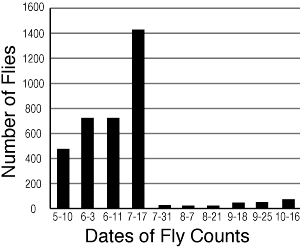Results
Entomologists have done studies on the control of midge and filter flies in wastewater facilities. It has been proven that the insect growth regulator (IGR) in Strike® products is highly effective in eliminating infestations and keeping them under control without the use of harmful ingredients.
Strike® Midge Control For Filter Flies at Barnesville, GA
By: D. Craig Sheppard Department of Entomology, University of Georgia Coastal Plain Experiment Station Tifton, GA 31793 Reprinted with Permission.
Filter flies, or moth flies, often breed in huge numbers in the gelatinous film covering the trickling filters at wastewater treatment plants. The dense flight of adults can cause nuisance situations at the site and nearby areas. Thermal or ULV aerosol insecticide treatments are recommended for adult control, but repeated treatments are needed for satisfactory control.
The study reported here explores a low-labor (S)-methoprene treatment that prevents adult emergence. In mosquitoes, (S)-methoprene, an insect growth regulator (IGR), prevents metamorphosis into the adult stage. Immature mosquitoes usually die as pupae. This same scenario is assumed for the filter fly.
Materials and Methods
This study was conducted at the municipal wastewater treatment plant in Barnesville, Ga. Adult filter flies were monitored periodically with seven, five by seven inch sticky cards positioned around the upper inside rim of the primary biological oxygen demand (BOD) tower (trickling filter). Sticky cards were usually placed in mid-morning when activity was high and were always left for 15 minutes. Captured flies were counted and recorded. Sampling dates are given in Table 1.
Table 1: Trickling Filter Fly Counts - Barnesville, Ga - 1996
Sticky Cards Exposed 15 Minutes
| Card # | 1 | 2 | 3 | 4 | 5 | 6 | 7 | Total |
| May 10 | 115 | 48 | 171 | 122 | 11 | 8 | - | 475 |
| May 31 | 57 | 93 | 130 | 94 | 131 | 112 | 109 | 726 |
| June 11 | 108 | 109 | 91 | 120 | 109 | 86 | 98 | 721 |
| July 10 | (S)-Methoprene treatment started | |||||||
| July 17 | 244 | 211 | 218 | 212 | 225 | 175 | 166 | 1451 |
| July 31 | 4 | 1 | 0 | 1 | 1 | 1 | 2 | 10 |
| August 7 | 0 | 0 | 0 | 0 | 2 | 1 | 2 | 5 |
| August 8 | Treatment stopped | |||||||
| August 21 | 3 | 0 | 1 | 0 | 0 | 0 | 1 | 5 |
| September 18 | 0 | 1 | 2 | 4 | 10 | 0 | 20 | 37 |
| September 25 | 3 | 9 | 3 | 5 | 8 | 7 | 8 | 43 |
| October 16 | 9 | 15 | 7 | 9 | 12 | 13 | 11 | 76 |
The larvicide treatment was five ounces of Strike® (20% (S)-methoprene) diluted in approximately 10 gallons of water and then introduced into the splitter box over 24 hours. The splitter box is positioned just before the primary BOD tower on the wastewater flow. This treatment was started on July 10, 1996 and continued for 29 days through August 7, 1996. Treatment was stopped on August 8, 1996.
Water samples were taken from the top and bottom of the primary BOD tower on August 7, the last full day of treatment. These were frozen and shipped on dry ice to Wellmark International in Dallas, TX for analysis of (S)-methoprene.
Results and Discussion
Adult filter fly counts are given in Table 1 and Figure 1. Sampling began on an increasing population with total counts going from 475 on May 10, 1996 to 1451 on July 17, 1996. At this higher level, they were judged to be abundant and a nuisance by the plant operator.
Figure 1: Filter Fly Counts - Barnesville, GA 1996

The (S)-methoprene treatment begun on July 10 had a clear effect by July 31, three weeks later. During the first week of treatment, adult numbers continued to increase to 1451, but had decreased to 10 two weeks later. Adult numbers continued to be very low for at least two weeks after treatment was stopped, and increased very slowly to 76 two months later. This was in mid-October, and cool nights were probably beginning to reduce adult emergence.
The 29 day (S)-methoprene treatment was judged to be highly successful, giving control up to 99.7 percent. In mid-October, plant personnel still judged control to be good, over two months after treatment had stopped.


